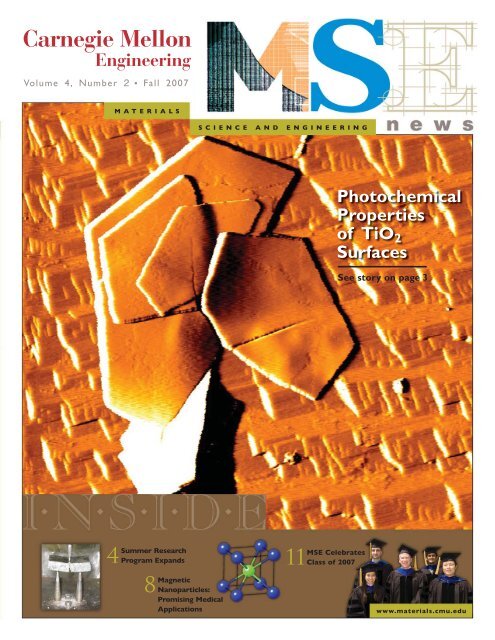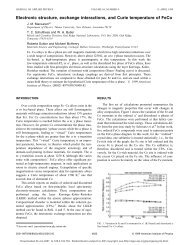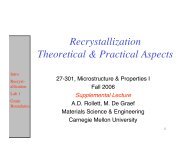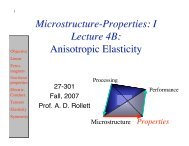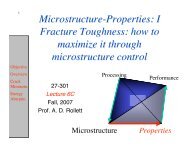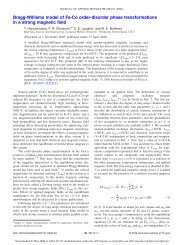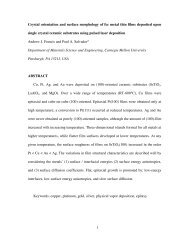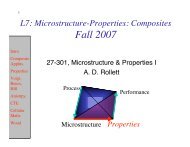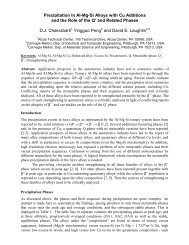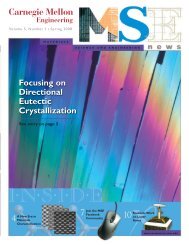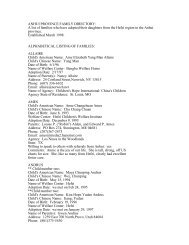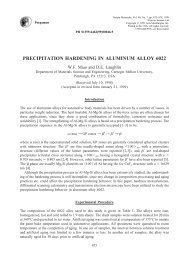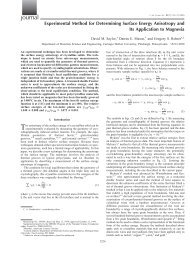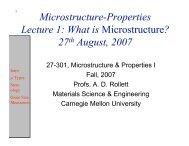CMU News (Page 2) - Materials Science and Engineering ...
CMU News (Page 2) - Materials Science and Engineering ...
CMU News (Page 2) - Materials Science and Engineering ...
You also want an ePaper? Increase the reach of your titles
YUMPU automatically turns print PDFs into web optimized ePapers that Google loves.
Carnegie Mellon<br />
<strong>Engineering</strong><br />
Volume 4, Number 2 • Fall 2007<br />
MATERIALS<br />
SCIENCE AND ENGINEERING<br />
4Summer Research<br />
MSE Celebrates<br />
Program Exp<strong>and</strong>s 11 Class of 2007<br />
8Magnetic<br />
Nanoparticles:<br />
Promising Medical<br />
Applications<br />
Photochemical<br />
Properties<br />
of TiO2<br />
Surfaces<br />
See story on page 3<br />
www.materials.cmu.edu
A Note<br />
From the<br />
Department Head<br />
Gregory S. Rohrer,<br />
W.W. Mullins<br />
Professor<br />
2<br />
Dear MSE Graduates:<br />
The last several months have seen the start of some exciting initiatives within the<br />
<strong>Materials</strong> <strong>Science</strong> <strong>and</strong> <strong>Engineering</strong> Department that exp<strong>and</strong> our interactions across<br />
the University, as well as aligning our own efforts with the missions of both CIT <strong>and</strong><br />
Carnegie Mellon.<br />
First, we exp<strong>and</strong>ed our Research Experiences for Undergraduates (REU) program to include<br />
28 participants. These students hailed from Carnegie Mellon, as well as from schools as far away<br />
as Arizona. During their 10-week stay here, they were advised not only by MSE faculty, but also<br />
by faculty members in Mechanical <strong>Engineering</strong>, Biomedical <strong>Engineering</strong>, Chemical <strong>Engineering</strong>, <strong>and</strong><br />
Physics. Initiated by Professor Mohammed Islam, the exp<strong>and</strong>ed summer research program<br />
embraces the entire materials research community across the University. Please see pages 4 <strong>and</strong> 5<br />
to learn more about this important initiative.<br />
Second, MSE faculty <strong>and</strong> students are now conducting research with the new Institute for<br />
Advanced Energy Studies, sponsored by the Department of Energy through the National Energy<br />
Technology Laboratory. The Institute sponsors research throughout CIT, <strong>and</strong> MSE’s research<br />
focuses on solid oxide fuel cells <strong>and</strong> materials for coal gasification reactors.<br />
This Fall, we have also welcomed Professor Jay<br />
Whitacre to our faculty. Because Jay is jointly appointed<br />
by the MSE <strong>and</strong> <strong>Engineering</strong> <strong>and</strong> Public Policy Departments,<br />
he will further exp<strong>and</strong> our interactions with others in CIT.<br />
Jay’s work focuses on materials for energy storage <strong>and</strong><br />
conversion systems, an area that is well aligned with both<br />
Departmental <strong>and</strong> CIT strategies. See page 3 for more<br />
information about Jay.<br />
This issue of the newsletter also highlights new advanced<br />
materials characterization equipment that has been added<br />
to the Department. Our new small-angle X-ray scattering<br />
system is described on page 6, <strong>and</strong> page 7 showcases the automated metallography device—called<br />
Robo-Met.3D—that MSE acquired in August. As we go to press, new funding has just been confirmed<br />
for an advanced Transmission Electron Microscope <strong>and</strong> an Environmental Scanning Electron<br />
Microscope, both of which will be added to the J. Earle <strong>and</strong> Mary Roberts <strong>Materials</strong> Characterization<br />
Facility. These new additions help to ensure that MSE’s facilities <strong>and</strong> technology resources remain<br />
state-of-the-art.<br />
I'd like to close by recalling the pleasure of attending the most recent Saltminers Dinner, held in<br />
Detroit in September. For those of you who could not make it, please put this alumni event on your<br />
calendar for next year. It is held annually at the MS&T meeting. As the MS&T meeting is scheduled<br />
to be held in Pittsburgh for the next two years, I hope to have the opportunity to see many of you<br />
on campus.<br />
Gregory S. Rohrer<br />
W.W. Mullins Professor <strong>and</strong> Department Head<br />
“ The last several months<br />
have seen the start of<br />
some exciting initiatives<br />
within the <strong>Materials</strong><br />
<strong>Science</strong> <strong>and</strong> <strong>Engineering</strong><br />
Department that exp<strong>and</strong><br />
our interactions across<br />
the University. ”
cover story<br />
MSE Undergraduate Studies Photochemical<br />
Properties of TiO 2 Surfaces<br />
Photochemical processes at TiO2 surfaces have been studied because of their<br />
importance for the conversion of solar energy, as well as their role in the performance<br />
of self-cleaning coatings. Of particular interest is the photocatalyzed synthesis of hydrogen<br />
fuel from sunlight <strong>and</strong> water (photolysis). If the efficiency of water photolysis by<br />
TiO2 can be increased <strong>and</strong> the cost reduced, it may provide a renewable source of<br />
hydrogen fuel. With this goal in mind, students in the Department of <strong>Materials</strong> <strong>Science</strong><br />
<strong>and</strong> <strong>Engineering</strong> are conducting research aimed at underst<strong>and</strong>ing the relationship<br />
between surface structure <strong>and</strong> the efficiency of photochemical reactions. The atomic<br />
force microscopy image on the cover was made by Lizza D. McGregor, Class of<br />
2007. The image shows platy crystals of hydrocerrusite, Pb3(CO3)2OH, formed<br />
during the photochemical oxidation of Pb(II) on the TiO2 surface. Although the<br />
hydrocerrusite is a “spectator” phase that is not central to the photochemical process,<br />
it is highly photogenic.<br />
faculty update<br />
Whitacre Joins<br />
MSE Faculty<br />
Jay Whitacre<br />
joined the Carnegie<br />
Mellon University<br />
faculty in September<br />
as an Assistant<br />
Professor in the<br />
Department of<br />
<strong>Materials</strong> <strong>Science</strong><br />
<strong>and</strong> <strong>Engineering</strong> <strong>and</strong> the Department of<br />
<strong>Engineering</strong> <strong>and</strong> Public Policy.<br />
Whitacre received his B.A. from<br />
Oberlin College in 1994, where he<br />
graduated with honors in Physics. He<br />
then earned his Masters (1997) <strong>and</strong> Ph.D.<br />
(1999) degrees in <strong>Materials</strong> <strong>Science</strong> from<br />
the University of Michigan, Ann Arbor.<br />
Whitacre was a Postdoctoral Scholar<br />
at the California Institute of Technology<br />
from 1999 to 2000. He subsequently<br />
became a Senior Member of the Technical<br />
Staff at the Jet Propulsion Laboratory<br />
(JPL) in Pasadena, California. His work<br />
there focused on synthesizing, characterizing,<br />
<strong>and</strong> implementing nanostructured<br />
materials for electrochemical devices<br />
such as Li-ion batteries <strong>and</strong> fuel cells. His<br />
other research topics included investigations<br />
of solid-state integrated hybrid<br />
energy collection <strong>and</strong> storage devices,<br />
high throughput materials selection<br />
methods, <strong>and</strong> conformal polymeric<br />
coatings for interplanetary space probes.<br />
Starting in 2004, Whitacre was trained<br />
as a Power Systems Engineer by the JPL<br />
systems design group. He subsequently<br />
became a member of “Team X,” a concurrent<br />
engineering design group focused on<br />
developing next-generation spacecraft.<br />
Whitacre’s charter in the Department<br />
of <strong>Materials</strong> <strong>Science</strong> <strong>and</strong> <strong>Engineering</strong> is to<br />
conduct research on materials for energy<br />
systems, while also considering the policy<br />
implications involved in selecting <strong>and</strong><br />
implementing the next generation of<br />
renewable energy technologies. His<br />
initial work will be focused on large<br />
format Li-ion batteries <strong>and</strong> novel PEM<br />
fuel cell catalyst materials <strong>and</strong> structures.<br />
Whitacre has received several awards<br />
in his career, including the MRS Graduate<br />
Research Award, Fall 1998 (silver medal);<br />
the 1999 University of Michigan<br />
Departmental Graduate Student Research<br />
Award; the 1999 American Vacuum Society<br />
Graduate Research Award (Thin Films<br />
Division); the 2001 Norman Hackerman<br />
Young Author Award (Electrochemical<br />
Society); <strong>and</strong> multiple JPL <strong>and</strong> NASA<br />
Space Act R&D Awards from 2002 to 2006.<br />
3
department news<br />
Summer <strong>Materials</strong> Research Program Exp<strong>and</strong>s<br />
Undergraduates <strong>and</strong> High School Teachers Benefit From Outreach Efforts<br />
The Department of <strong>Materials</strong> <strong>Science</strong> <strong>and</strong> <strong>Engineering</strong> is committed to establishing<br />
its leadership in both research <strong>and</strong> education. For the past 10 years, the Department<br />
has been organizing summer research programs for undergraduates <strong>and</strong> local<br />
high school teachers, sponsored by the <strong>Materials</strong> Research <strong>Science</strong> <strong>and</strong> <strong>Engineering</strong><br />
Center (MRSEC). Starting this year, the summer program has been exp<strong>and</strong>ed with funding from<br />
the National <strong>Science</strong> Foundation (NSF) Research Experiences for Undergraduates (REU)<br />
program, MSE, Chemical <strong>Engineering</strong>, Biomedical <strong>Engineering</strong>, MRSEC, <strong>and</strong> PREM (Partnership<br />
for Research <strong>and</strong> Education in <strong>Materials</strong>), a collaborative effort of Carnegie Mellon <strong>and</strong> the<br />
Florida Agricultural <strong>and</strong> Mechanical University.<br />
Some of the 28 participants in MSE’s summer undergraduate<br />
programs pose after making their final presentations.<br />
Undergraduate students from Carnegie Mellon <strong>and</strong> several other universities from across<br />
the country performed cutting-edge interdisciplinary research within seven departments <strong>and</strong><br />
two colleges at Carnegie Mellon. Their work included intra- <strong>and</strong> inter-departmental collaborations<br />
between researchers, allowing the students to interact with faculty, graduate students, <strong>and</strong> undergraduates<br />
from a wide variety of disciplines. In addition, the summer program provided an opportunity<br />
for four high school teachers to develop appropriate science <strong>and</strong> engineering curricula.<br />
“In today’s interdisciplinary materials research <strong>and</strong> educational environment, MSE must reach<br />
out to other disciplines, introducing them to the latest thinking in materials science <strong>and</strong> engineering,”<br />
says Department Head Gregory S. Rohrer. “By introducing students from other<br />
engineering fields <strong>and</strong> natural sciences to materials science, we can demonstrate the connections<br />
between our research <strong>and</strong> their own interests—which will encourage innovation <strong>and</strong><br />
4<br />
“ In today’s interdisciplinary<br />
materials research <strong>and</strong> educational<br />
environment, MSE must<br />
reach out to other disciplines,<br />
introducing them to the latest<br />
thinking in materials science<br />
<strong>and</strong> engineering. ”
interdisciplinary collaboration. And, by working to educate local high school teachers, we are<br />
creating a greater level of interest among young people—<strong>and</strong> ensuring that our field has a<br />
bright future.”<br />
REU: Building Interdisciplinary Connections<br />
Undergraduates in various engineering fields, physics, <strong>and</strong> chemistry from schools across the<br />
country were invited to apply for a 10-week summer research program—during which they<br />
would receive a stipend of $3800, on-campus housing, <strong>and</strong> additional funds for travel.<br />
This summer, 28 undergraduates were selected from a pool of more than 150 applicants,<br />
based on their academic st<strong>and</strong>ing <strong>and</strong> faculty recommendations. Ten students were chosen<br />
from across Carnegie Mellon, <strong>and</strong> 18 students were selected from universities across the<br />
country. The 10-week program began with a campus <strong>and</strong> housing orientation, project definition,<br />
lab safety training, <strong>and</strong> a good research practices workshop with an ethics overview.<br />
After five weeks, a symposium was held, where all the students presented oral reports on<br />
their project goals, progress to date, <strong>and</strong> plans for the second half of the summer.The summer<br />
concluded with final oral reports in a second symposium; each student also produced a<br />
research highlight, prepared a written paper, <strong>and</strong> answered a questionnaire.<br />
The summer program was punctuated by additional educational activities such as minicourses<br />
taught by MSE faculty, a seminar series for professional development, <strong>and</strong> fun activities<br />
including a Pittsburgh Pirates baseball game, an awards ceremony, <strong>and</strong> a wrap-up picnic that<br />
adjourned the 2007 summer program..<br />
Preparing the Next Generation<br />
The Summer <strong>Materials</strong> Research Program also sponsored educational activities for local high<br />
school teachers, with the goal of introducing secondary students to materials science.<br />
Four high school teachers participated in an intense curriculum development program—the<br />
impact of which will be multiplied across the students who attend their classes over the next<br />
several years.<br />
During his summer internship, Eric Laurenson, Physics Teacher at Peabody High School,<br />
distinguished himself by preparing a report entitled “Fracturing of Brittle <strong>Materials</strong>: The Study of<br />
Marble <strong>and</strong> Granite” that includes research objectives, background materials, lesson plans, <strong>and</strong><br />
supply lists. Laurenson’s report can be used by other teachers to introduce high school students<br />
to the analysis of mechanical <strong>and</strong> structural properties of materials, as well as the concepts of<br />
triple-point <strong>and</strong> compression testing.<br />
Two high school teachers who had participated in previous summer internships at MSE<br />
returned this year to hold an intensive two-day workshop for their peers on June 22-23.<br />
Yue Chu, <strong>Science</strong> <strong>and</strong> Math Teacher at Brashear High School, instructed an audience of<br />
Pittsburgh teachers in developing materials science lessons plans on the topic of “Monte Carlo<br />
Modeling.” F. Michael Real, Earth <strong>and</strong> Space <strong>Science</strong> Teacher at Taylor Allderdice High School,<br />
addressed lesson planning around the topic “Selection of Building <strong>Materials</strong>.”<br />
This two-day event enabled the participating teachers to return to their classrooms with a<br />
variety of lesson plans <strong>and</strong> activities that they can incorporate into their own science curriculum—<br />
exposing a new generation of students to leading-edge topics in materials science <strong>and</strong> engineering.<br />
Kristina Breuer <strong>and</strong> Kelly Collier<br />
received awards for Best Research<br />
Highlight at the conclusion of the<br />
summer program.<br />
Chinmaobi Onwunli presents his<br />
research project at the final symposium.<br />
5
Small-Angle X-Ray Scattering: A Whole New Dimension<br />
X-ray scattering <strong>and</strong> diffraction are among the principal tools for studying the structure of materials. Particularly well<br />
known examples are X-ray crystallographic methods that are used to elucidate the atomic arrangement of<br />
crystalline materials.<br />
However, in many instances—<strong>and</strong>, in particular, for polymeric materials—knowledge of the atomic arrangements within crystalline<br />
regions is not sufficient to fully characterize the morphology of a material. Researchers also need to know about the arrangement of<br />
structural entities on lengthscales ranging from 5 to 100 nm (the so-called<br />
mesoscopic region). Small-angle X-ray scattering (SAXS) helps to resolve<br />
these lengthscales by essentially analyzing the broadening of a collimated<br />
X-ray beam as it traverses the sample.<br />
Through a grant from the National <strong>Science</strong> Foundation (NSF), the<br />
Department of <strong>Materials</strong> <strong>Science</strong> <strong>and</strong> <strong>Engineering</strong> has added a new<br />
RIGAKU combined small- <strong>and</strong> wide-angle scattering apparatus that will help<br />
to concurrently resolve structures on the atomic <strong>and</strong> mesoscopic scale. It<br />
adds a whole new dimension to the already existing X-ray crystallographic<br />
infrastructure in the Department, <strong>and</strong> signifies MSE’s determined progress<br />
in the areas of soft <strong>and</strong> nanostructured materials.<br />
As the first dedicated SAXS instrument in the Pittsburgh area, this apparatus<br />
also strengthens the position of the Department as a center of excellence in<br />
materials characterization—<strong>and</strong> a resource for researchers both within <strong>and</strong><br />
outside Carnegie Mellon University.<br />
Shown here is the RIGAKU combined small- <strong>and</strong> wide-angle<br />
scattering apparatus recently acquired by MSE.<br />
Example: Polyethylene<br />
Analysis of a Material With Order on the Nano <strong>and</strong> Mesoscale<br />
Due to the simplicity of its chemical structure, polyethylene is the archetype that was<br />
fundamental to researchers’ underst<strong>and</strong>ing of the solid-state structure of crystalline polymers.<br />
The long-chain nature of the polymer molecules implies that the crystallization process results<br />
in lamellar “stacks” of crystalline <strong>and</strong> amorphous layers.<br />
Structural parameters used to describe such a “semi-crystalline” material are the degree of<br />
crystallinity, the thickness of crystalline <strong>and</strong> amorphous layers, <strong>and</strong> the (crystal) structure<br />
of the crystalline layers.<br />
Only with the advent of combined small- <strong>and</strong> wide-angle scattering techniques is it<br />
possible to determine the complete set of structural parameters in one experiment.The<br />
figure at right illustrates the principal set-up of the experiment, as well as the two-dimensional<br />
scattering characteristics of polyethylene films from which both the mesoscopic order (lamellar<br />
spacing, SAXS) <strong>and</strong> the atomic arrangement within the crystalline layers (orthorhombic,<br />
WAXS) can be determined.<br />
6
Robot-Controlled Metallography<br />
A Step Toward Automated 3-D <strong>Materials</strong> Characterization<br />
In August 2007, the Department of <strong>Materials</strong> <strong>Science</strong> <strong>and</strong> <strong>Engineering</strong><br />
placed an order with UES, Inc., in Beavercreek, Ohio, for the<br />
construction of an automated metallography device known as<br />
Robo-Met.3D.<br />
This tool, designed by Jonathan Spowart <strong>and</strong> his colleagues at Wright<br />
Patterson Air Force Base (WPAFB) in Dayton, Ohio, employs a robot<br />
arm with six degrees of freedom to approximate what a human<br />
metallographer would do by h<strong>and</strong>.<br />
While manually obtaining a single 2-D metallographic section is a<br />
routine operation that should be familiar to all MSE graduates, obtaining<br />
a large number of consecutive sections—known as serial sectioning—is<br />
time-consuming (not to men-<br />
“ While manually obtaining tion mind-numbing). To speed<br />
a single 2-D metallographic up this process, the Robo-<br />
Met.3D uses a robot arm<br />
section is a routine operation<br />
which moves the sample, with<br />
that should be familiar to all<br />
a high degree of accuracy <strong>and</strong><br />
MSE graduates, obtaining a large reproducibility, between the<br />
number of consecutive sections— main stations shown in Figure<br />
known as serial sectioning—is 1: the polishing unit, the etch-<br />
time-consuming. ing/rinsing/drying unit, <strong>and</strong> the<br />
”<br />
optical microscope.<br />
A typical cycle consists of three distinct steps. First, the robot arm<br />
mounts the sample on a stage that lowers it to the surface of a precision<br />
polishing unit, where it is polished for a set time. Next, the robot<br />
arm moves the sample through a series of rinsing <strong>and</strong> drying steps—<br />
with a potential acid etch in between these steps. Finally, the sample is<br />
moved onto a high-precision x-y stage mounted above a Zeiss metallographic<br />
microscope, where one or more images are automatically<br />
recorded <strong>and</strong> stored. Large areas can be imaged by means of an image<br />
stitching procedure.<br />
The entire operation is then repeated until the preset number of<br />
sections has been obtained. After the images have been acquired, additional<br />
image processing steps are needed to register the entire 3-D<br />
stack <strong>and</strong> produce a true 3-D digital microstructure. The Robo-Met.3D<br />
instrument shortens the data acquisition time from several months of<br />
manual work to a few days of unsupervised operation.<br />
There are currently only two other Robo-Met.3D instruments in<br />
use. One is at WPAFB, <strong>and</strong> one is at Ohio State University in Columbus,<br />
Ohio. MSE’s instrument, which was acquired with AFOSR DURIP funding,<br />
will be installed in January 2008, <strong>and</strong> will be equipped with an additional<br />
Laue X-ray unit. This unit will consist of a precision x-y stage, a<br />
Figure 1: The Robo-Met.3D device features a polishing unit, an<br />
etching/rinsing/drying unit, <strong>and</strong> an optical microscope.<br />
micro-focus high-intensity X-ray tube, <strong>and</strong> a CCD camera for recording<br />
reflection Laue patterns.<br />
Using customized software, the Laue patterns will be indexed automatically<br />
so that, in addition to microstructural information, the unit will<br />
also be able to produce orientational data. The instrument will be<br />
housed in the lab of Professor Marc De Graef in Roberts<br />
<strong>Engineering</strong> Hall. It will be used primarily by students associated with the<br />
research groups of De Graef <strong>and</strong> Professor Anthony D. Rollett.<br />
Piehler’s Retirement<br />
Celebrated<br />
Professor Henry R. Piehler<br />
has officially retired after 40 years<br />
of dedicated teaching <strong>and</strong><br />
research. Family, friends, <strong>and</strong> colleagues<br />
gathered for a celebration<br />
of his long <strong>and</strong> successful career<br />
on June 29 at the Pittsburgh<br />
Athletic Association. Piehler will remain active in the<br />
Department—<strong>and</strong> can also be found at Pittsburgh’s Heinz Field,<br />
where he is known as the Steelers’ #1 fan.<br />
7
McHenry Focuses on Biomedical <strong>Engineering</strong><br />
The research group of Professor Michael McHenry is<br />
investigating applications of magnetic nanoparticles in biomedical<br />
engineering. This research project includes utilizing<br />
the efficient point source heating of metal nanoparticles for<br />
thermoablative cancer therapies.<br />
This work is being done in collaboration with MSE’s Professor<br />
Michael Bockstaller, as well as Dr. Preet Chaudhary of the Hillman<br />
Cancer Research Center at UPMC. The team is focused on tagging <strong>and</strong><br />
changing the shape of tissue scaffolds, in collaboration with the McGowan<br />
Tissue <strong>Engineering</strong> Center at UPMC, MSE alumnus Dr. Tom Gilbert, <strong>and</strong><br />
his colleague Dr. Steve Badylak.<br />
The application of magnetic nanoparticles requires adherent, biocompatible<br />
oxide shells functionalized to stabilize aqueous ferrofluids. The research<br />
uses the materials paradigm in (1) developing knowledge of plasma torch<br />
synthesis of appropriately sized core-shell nanoparticles, (2) identifying<br />
crystallographic facets of metallic nanoparticles, (3) underst<strong>and</strong>ing orientation<br />
relationships between thin, stable adherent oxide shells <strong>and</strong> the metal<br />
core, (4) measurement of magnetic <strong>and</strong> magnetoelastic properties, <strong>and</strong><br />
(5) assessment of the performance of the nanoparticles in RF heating <strong>and</strong><br />
magnetoelastic applications.<br />
Research has been pursued through two MSE Capstone Design Projects<br />
(Fall 2006), a BME Capstone Design Project (Spring 2007), <strong>and</strong> Summer<br />
2007 REU research with funding from the American Chemical Society <strong>and</strong><br />
Carnegie Mellon ICES PITA.<br />
Project Results in Publications, Awards<br />
This collaborative effort has resulted in a number of published papers <strong>and</strong><br />
awards for team members:<br />
• The research of Ashfaque Habib <strong>and</strong><br />
Courtney Ondeck will be presented<br />
at the 2007 Magnetism <strong>and</strong> Magnetic<br />
<strong>Materials</strong> (MMM) Conference. A paper<br />
entitled “Evaluation of Iron-Cobalt/Ferrite<br />
Core-Shell Nanoparticles for Cancer<br />
Thermotherapy” has been submitted to<br />
the Journal of Applied Physics.<br />
• Kelsey Miller has submitted a paper<br />
to the Journal of Applied Physics entitled<br />
“FeCo Nanoparticles for the In-Vivo<br />
Tracking of ECM Scaffold Degradation<br />
Products.”<br />
8<br />
• Matt Jones <strong>and</strong> Marybeth Wilson<br />
won the Phi Kappa Theta Award at the<br />
2007 Carnegie Mellon “Meeting of the<br />
Minds” event for their paper, “FeCo<br />
Magnetic Nanoparticles for Extra Cellular<br />
Matrix Tissue <strong>Engineering</strong> Scaffold<br />
Degradation Tracking.”<br />
• Rebecca Snyder was awarded second<br />
prize in the “Surgery for Engineers” course<br />
for her research paper called “Use of<br />
Ferrogels to Improve Catheter Navigational<br />
Control: Neurointerventional Radiology-<br />
Based Applications.”<br />
Figure 1 shows the work of Kelly Collier in modeling crystal<br />
facets <strong>and</strong> orientation relationships between FeCo cores<br />
<strong>and</strong> ferrite shells in HRTEM images taken by Yuling Qin.<br />
• James Rogers won third prize in the<br />
2007 CIT Honors research competition<br />
for his paper, “Synthesis of FeCo Nanorods<br />
to Act as Heat Sources for Thermoablative<br />
Cancer Therapy.”<br />
• Carnegie Mellon freshman Kelly Collier<br />
<strong>and</strong> Florida State senior Kristina Breuer<br />
were also awarded prizes as part of a<br />
successful NSF-sponsored REU program.
alumni news<br />
Sheldon (Lee)<br />
Semiatin (M.S. ’72, Ph.D.<br />
’77) has been named the<br />
2007 recipient of the Gold<br />
Medal of ASM. He was cited<br />
for his outst<strong>and</strong>ing contributions<br />
to the development<br />
<strong>and</strong> application of fundamental underst<strong>and</strong>ing<br />
of thermo-mechanical <strong>and</strong> other<br />
advanced processes for aerospace materials,<br />
including both conventional metallic <strong>and</strong> intermetallic<br />
alloys. Semiatin is Senior Scientist,<br />
<strong>Materials</strong> Processing/Processing <strong>Science</strong> <strong>and</strong><br />
Research Leader, Metals Processing Group, in<br />
the Air Force Research Laboratory, <strong>Materials</strong><br />
<strong>and</strong> Manufacturing Directorate.<br />
.....<br />
Glenn Beltz (B.S. '88),<br />
Assistant Professor of<br />
Mechanical <strong>Engineering</strong> at<br />
the University of California,<br />
Santa Barbara, recently<br />
accepted the appointment<br />
of Associate Dean for<br />
Undergraduate Studies in the UCSB College<br />
of <strong>Engineering</strong>.<br />
.....<br />
George T. “Rusty”<br />
Gray III (Ph.D. ’82) was<br />
named a Fellow of the<br />
American Physical Society.<br />
Gray was selected for his<br />
“important contributions to<br />
the underst<strong>and</strong>ing of defect<br />
generation <strong>and</strong> storage in materials subjected<br />
to shock loading, <strong>and</strong> for advancing the stateof-the-art<br />
of shock recovery techniques to<br />
benefit shock physics.”<br />
Alumni Profile: Cindy Giroux<br />
Since graduating from the Department of <strong>Materials</strong> <strong>Science</strong> <strong>and</strong> <strong>Engineering</strong>,<br />
Cindy Giroux (B.S. ’80, M.S. ’85) has been employed by Corning Incorporated,<br />
where she has performed a wide range of process engineering, development,<br />
<strong>and</strong>, most recently, corporate research. Giroux has worked on industrialization,<br />
scale-up, <strong>and</strong> cost reduction of optical fiber production—as well as new<br />
product development for fiber <strong>and</strong> optical components.<br />
Five years ago, Giroux moved into her current role as Technology Director, Thin Films <strong>and</strong><br />
Surfaces Research, where she leads a group of 35 people who work on electronics on glass, selfassembly,<br />
carbon materials, <strong>and</strong> deposition <strong>and</strong> patterning of inorganic thin films. She is co-inventor<br />
on six US patents.<br />
Giroux is active in her community as a leader of the corporate fundraising program for the<br />
Seven Lakes Girl Scout Council. She also rides her bike in an annual charity event for the Juvenile<br />
Diabetes Research Foundation (JDRF) <strong>and</strong> serves on the Board of Trustees for the Rockwell<br />
Museum of Western Art. Giroux <strong>and</strong> her husb<strong>and</strong>, Marc, live in Corning, New York, with their<br />
two Shetl<strong>and</strong> sheepdogs.<br />
George E. Maley<br />
(B.S. ’47) was on h<strong>and</strong> for<br />
CIT’s 2007 Homecoming<br />
Reception, where he<br />
celebrated the platinum<br />
anniversary of his graduation.<br />
Maley, a veteran of<br />
World War II, spent 38 years at the ABEX<br />
Corporation. He currently resides in<br />
Tucson, Arizona, where he is a dedicated<br />
fan of the University of Arizona women’s<br />
basketball team.<br />
.....<br />
Clare M. Rimnac<br />
(B.S. ’78) was named Chair<br />
of the Department of<br />
Mechanical <strong>and</strong> Aerospace<br />
<strong>Engineering</strong> at Case<br />
Western Reserve<br />
University in July. Rimnac<br />
also holds the Wilbert J. Austin Professor of<br />
<strong>Engineering</strong> endowed chair.<br />
In Memoriam<br />
<br />
We recently learned that John E. Hatch<br />
(M.S. ’48) passed away on April 13, 2007.<br />
Hatch began his career at ALCOA in 1940.<br />
During his tenure there, he was on the team<br />
that developed the alloys for the wings of the<br />
737 <strong>and</strong> 747, as well as the team that developed<br />
the aluminum beer can in the 1960s.<br />
Hatch also directed the computerization of lot<br />
tickets, st<strong>and</strong>ard practices, <strong>and</strong> order entry. He<br />
retired from ALCOA in 1977, after 37 years<br />
of service. In 1978, he started teaching at<br />
Carnegie Mellon University. He taught a course<br />
that he developed on “Practical Metallurgy,”<br />
which addressed how to do presentations in<br />
the work environment. While teaching at<br />
Carnegie Mellon, Hatch edited the book<br />
Aluminum: Properties <strong>and</strong> Metallurgy (1984)<br />
for ASM.<br />
9
MSE Donors: Making a Difference<br />
The Department of <strong>Materials</strong> <strong>Science</strong> <strong>and</strong> <strong>Engineering</strong> would like to thank the<br />
following donors for their contributions to the Department in fiscal year ’07.<br />
Alumni generosity is important to MSE, <strong>and</strong> is greatly appreciated.<br />
Contributions from loyal MSE graduates, parents, <strong>and</strong> friends serve many purposes.<br />
For example, their financial support allows the Department to provide funding for undergraduate<br />
research projects, as well as to continuously improve undergraduate laboratory<br />
facilities. Funds are also used to upgrade the Department’s computing facilities <strong>and</strong> to<br />
support projects developed in the MSE Capstone Design course.<br />
MSE is committed to providing an outst<strong>and</strong>ing educational experience for all students,<br />
<strong>and</strong> the continued support of our alumni <strong>and</strong> friends helps us to achieve this goal.<br />
Aaronson, Hubert I.<br />
Albert, Robert L.<br />
Allison, John E.<br />
Bailey, Arthur<br />
Banks, William C.<br />
Bartel, Thomas G.<br />
Bedillion, Mark David<br />
Birciw, John<br />
Bloch, Richard J.<br />
Brooks, John A.<br />
Brown, Kevin C.<br />
Burquist, William A.<br />
Bytnar, James Henry<br />
Campbell, Ronald C.<br />
Cerully, Laura B.<br />
Chan, Karena Yeeman<br />
Ching, Kalani<br />
Choi, Daiwon<br />
Chookajorn, Tongjai<br />
Cinkovic, Terrea<br />
Cirra, JoAnn H.<br />
Clark Esq., Richard K.<br />
Clum, James A.<br />
Colarossi, Tony<br />
Cook, Celeste R.<br />
Cooley, Calvin J.<br />
Cos<strong>and</strong>ey, Frederic<br />
Cox Jr., John J.<br />
Cox, Thomas B.<br />
Crews, Andrea M.<br />
Crosbie, Gary M.<br />
Danko, Joseph C.<br />
10<br />
Dapos, Elio<br />
Darby, Michele L.<br />
Davis, Bert N.<br />
Di Tommaso, Anthony<br />
Dieter Jr., George E.<br />
Dimiduk, Dennis M.<br />
Donegan, Jennifer L.<br />
Drage, David Jack<br />
Dresher, Ronald J.<br />
Dukelow, Donald A.<br />
Edwards, William P.<br />
Emerick, Harold B.<br />
Erwin, William E.<br />
Forbes, Robert E.<br />
Fortini, Otavio<br />
Fountain III, Alton N.<br />
Fox, Arthur V.<br />
Gibala, Ronald<br />
Goldman, Kenneth M.<br />
Goodwald, Jerry A.<br />
Gordon, Barry M.<br />
Grace, Richard E.<br />
Grguras, Richard<br />
Guerry Jr., John B.<br />
Ha, Seoyong<br />
Harrover Jr., Robert E.<br />
Hart III, Joseph H.<br />
Hartman, Thomas L.<br />
Heckel, Richard W.<br />
Helfer, Farrel B.<br />
Hirth, John Price<br />
Hoffman, Emily E.<br />
Hoffmanner, Albert L.<br />
Houska, Catherine M.<br />
Hresko III, George C.<br />
Huebschman, Jennifer Rebecca<br />
Huh, Sung Wook<br />
Jaffe, Donald<br />
Joseph, Thomas M.<br />
Kaune, James E.<br />
Kelly, Paul C.<br />
Kenin, Maxine<br />
Kerlin, Kerry J.<br />
Kline, Martin A.<br />
Knoth, Roy J.<br />
Komolwit, Piyamanee<br />
Konoval, George<br />
Lambert, William N.<br />
L<strong>and</strong>erman, Edgar<br />
Lange, Walter F.<br />
Larsen, James Milligan<br />
LaSalvia, Robyn L.<br />
Lee, Hyun K.<br />
Lew<strong>and</strong>owski, John J.<br />
Lherbier, Louis W.<br />
Littman, Lawrence E.<br />
Lu, Weier Larry<br />
Lutz, Carl F.<br />
Lynn, Lawrence H.<br />
Madjaric, Edward T.<br />
Marinis Jr., Thomas F.<br />
Maxton, Robert C.<br />
McFadden, Robert Simboli<br />
Mighton, John W.<br />
Miller, Herbert M.<br />
Miller, Reed A.<br />
Miller, Timothy Alan<br />
Mills, Robert C.<br />
Mitchell, Conrad<br />
Montgomery, Allen M.<br />
Mullins, Garrick R.<br />
Mullins, Oliver C.<br />
Narayanan, Kesh S.<br />
Narayanan, Vijay<br />
O'Connell, Thomas E.<br />
Paxton, Harold W.<br />
Perepezko, John H.<br />
Philips, Brett A.<br />
Pomraning, Stephen R.<br />
Porter, Lisa M.<br />
Puglielli, Diane<br />
Pyle Jr., George M.<br />
Rao, Lalitha<br />
Reinshagen, John H.<br />
Reynolds, William T.<br />
Rigoni, Leslyn Green<br />
Robinson, George H.<br />
Roudabush, Lisa A.<br />
Russell, Kenneth C.<br />
Satterwhite, Keith D.<br />
Sauvageot Jr., A. Burt<br />
Schlosberg, William H.<br />
Schwartz, Aaron<br />
Shields, Bruce M.<br />
Siebert, William R.<br />
Simmons, Jeff P.<br />
Singelyn, Jennifer M.<br />
Smith, Paul Andrew<br />
Snee, David J.<br />
Sohn, Il<br />
Squire, Frederick J.<br />
Steyer, Todd E.<br />
Stosuy, Athan<br />
Taylor, Jerry M.<br />
Van Saun, John B.<br />
Wang, Yarw-Nan<br />
Warner, Howard R.<br />
Willard, Matthew Ashe<br />
Williams, Robert K.<br />
Wolf, Robert E.<br />
Wolfe, Richard A.<br />
Woods, Charles R.
Commencement I Class of 2007<br />
The 2007 MSE Diploma ceremony was<br />
held on May 20. The auditorium was filled<br />
to capacity with family, friends, <strong>and</strong> faculty<br />
congratulating the new graduates on a job<br />
well done—<strong>and</strong> wishing them the best in<br />
their future endeavors. Many of the graduates<br />
planned to further their education in doctoral<br />
programs across the country, at schools such<br />
as Northwestern, Caltech, UC Santa Barbara,<br />
Stanford, <strong>and</strong> the University of Pennsylvania.<br />
Other graduates found employment at<br />
top-notch companies including Nucor Steel,<br />
Johnson & Johnson, Dow Chemicals Company,<br />
L’Oreal USA, Accelent, General Electric, BP,<br />
<strong>and</strong> Reckitt Benckiser.<br />
.....<br />
During the ceremony, many awards were presented.<br />
Keng Yong Goh received the Mullins<br />
Award, which is given to the graduating senior<br />
in MSE who best exemplifies the qualities associated<br />
with Professor Bill Mullins. Upon<br />
graduation, Goh began a position with the<br />
Agency of <strong>Science</strong> Technology <strong>and</strong> Research’s<br />
Data Storage<br />
Institute in<br />
Singapore.<br />
.....<br />
Fiona Wang <strong>and</strong><br />
Wei Wang<br />
The Paxton<br />
Award for the<br />
Best Doctoral<br />
Dissertation in<br />
MSE was given to<br />
Paolo Nolli for<br />
his thesis “Initial Solidification Phenomena:<br />
Factors Affecting Heat Transfer in Strip<br />
Casting.” Nolli is currently working as an R&D<br />
Engineer with Vesuvius Research in Pittsburgh.<br />
.....<br />
The Hubert I. Aaronson Undergraduate Award,<br />
which is given to a deserving undergraduate<br />
metallurgy student who is planning to attend<br />
Hua Yuan<br />
graduate school, was presented to<br />
Esther P.Yu. She is enrolled at the<br />
University of Pennsylvania as a doctoral<br />
student, with a concentration in<br />
Biomaterials <strong>and</strong> Tissue <strong>and</strong> Cell<br />
<strong>Engineering</strong>.<br />
.....<br />
Matthew R. Jones was awarded<br />
the James W. Kirkpatrick <strong>and</strong> Jean<br />
Keelan Kirkpatrick Scholarship, given<br />
to “a graduating senior who has best<br />
supplemented his/her intellectual<br />
abilities with effort <strong>and</strong> work ethic.”<br />
Jones is attending Northwestern<br />
University as a doctoral student,<br />
where he has been awarded the<br />
Ryan Fellowship for nanoscience<br />
<strong>and</strong> technology.<br />
.....<br />
Mary Beth Wilson received the<br />
William T. Lankford Jr. Memorial<br />
Scholarship, which is presented each<br />
year to a student in the Department<br />
who exemplifies the attributes associated<br />
with Bill Lankford—true<br />
scholarship, high st<strong>and</strong>ards, great<br />
potential, <strong>and</strong> the willingness to help<br />
others unselfishly. Wilson is currently<br />
enrolled at the University of Alabama<br />
at Birmingham in its six-year<br />
D.M.D./Ph.D. program, which offers a<br />
dual degree in dental medicine <strong>and</strong><br />
biomedical engineering.<br />
Scott Roberts <strong>and</strong> James Rogers<br />
Ruby Chen <strong>and</strong> Abbie Bednar<br />
Shown left to right:<br />
Nan Boonyachut, Paolo Nolli,<br />
Professor Greg Rohrer,<br />
Sai Venkateswaran, <strong>and</strong><br />
Wanlin Wang<br />
▼<br />
Amber Fuller<br />
Katie Benintende
Department of<br />
<strong>Materials</strong> <strong>Science</strong><br />
<strong>and</strong> <strong>Engineering</strong><br />
Carnegie Mellon University<br />
Pittsburgh, PA 15213-3890<br />
Department Head<br />
Gregory S. Rohrer<br />
Editor<br />
Suzanne B. Smith<br />
Photographers<br />
Ken Andreyo<br />
Glenn Brookes<br />
Designer<br />
Dan Hart<br />
Carnegie Mellon University does not discriminate <strong>and</strong> Carnegie Mellon University is required<br />
not to discriminate in admission, employment, or administration of its programs or activities on<br />
the basis of race, color, national origin, sex, or h<strong>and</strong>icap in violation of Title VI of the Civil Rights<br />
Act of 1964, Title IX of the Educational Amendments of 1972, <strong>and</strong> Section 504 of the<br />
Rehabilitation Act of 1973, or other federal, state, or local laws or executive orders.<br />
In addition, Carnegie Mellon University does not discriminate in admission, employment, or<br />
administration of its programs on the basis of religion, creed, ancestry, belief, age, veteran status, or sexual<br />
orientation, or in violation of federal, state, or local laws or executive orders. However, in the judgment of the<br />
Carnegie Mellon Human Relations Commission, the Department of Defense policy of “Don’t ask, don’t tell, don’t<br />
pursue” excludes openly gay, lesbian, <strong>and</strong> bisexual students from receiving ROTC scholarships or serving in the<br />
military. Nevertheless, all ROTC classes at Carnegie Mellon University are available to all students.<br />
Inquiries concerning application of these statements should be directed to the Provost, Carnegie Mellon<br />
University, 5000 Forbes Avenue, Pittsburgh, PA 15213, telephone (412) 268-6684, or to the Vice President for<br />
Enrollment, Carnegie Mellon University, 5000 Forbes Avenue, Pittsburgh, PA 15213, telephone (412) 268-2056.<br />
Obtain general information about Carnegie Mellon University by calling (412) 268-2000.<br />
Carnegie Mellon University publishes an annual campus security report describing the University’s security,<br />
alcohol <strong>and</strong> drug, <strong>and</strong> sexual assault policies, <strong>and</strong> containing statistics about the number <strong>and</strong> type of crimes<br />
committed on the campus during the preceding three years. You can obtain a copy by contacting the Carnegie<br />
Mellon Police Department at (412) 268-2323. The security report is also available at www.cmu.edu/security.<br />
Carnegie Mellon University makes every effort to provide accessible facilities <strong>and</strong> programs for individuals with<br />
disabilities. For accommodations/services, please contact the Equal Opportunity Office at (412) 268-2012.<br />
It’s Official:<br />
Carnegie Mellon<br />
Is Cool!<br />
Sierra Magazine recently<br />
ranked Carnegie Mellon<br />
the 10th Coolest School,<br />
in honor of the University’s<br />
efforts to create a “greener”<br />
campus. The publication is<br />
the national magazine of the Sierra Club,<br />
with 1.2 million readers. The article recognized<br />
Carnegie Mellon for a number of<br />
green initiatives—including the studentdesigned<br />
green roofs atop The Posner<br />
Center <strong>and</strong> Hamerschlag Hall; the nation’s<br />
first eco-friendly residence hall, New House;<br />
<strong>and</strong> the Collaborative Innovation Center,<br />
which features a modular raised-floor<br />
system that doubles the building’s fresh air<br />
circulation. Read the full article at<br />
http://www.sierraclub.org/sierra.


